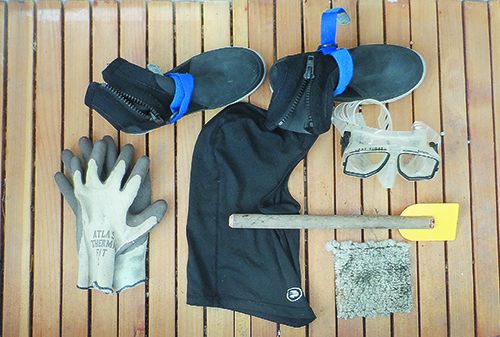This month’s report on alternative bottom paints called to mind Drew Frye’s report (see Bottom Cleaning PS April 2018) on bottom cleaning, a practice that can help prolong the protection hard or specialized paints like Coppercoat, which can require physical abrasion to remain active. Here are some of the most essential tips Frye offered:
Check local rules. Marinas are regulated under the Clean Water Act and they often have their own policies regarding DIY hull-cleaning.
Work slowly. You are going to be in the water for 30-50 minutes, treading water. Becoming exhausted by working at a dry land pace is potentially dangerous. Even experienced swimmers can black from holding their breath too long while working too hard. Keep the dives short and work at an easy pace you can maintain. Wearing a PFD can be helpful for the waterline portion. If you have any reservations about your abilities as a swimmer, a helper watching with a throwable PFD and a boat hook is smart. You also don’t have to clean the whole boat in one day. Perhaps tackling just 25 percent each day will suit you better.
Boarding Ladder. This seems obvious, but many boats have no practical way to reboard if you are tired. There should be at least two step fully submerged, and three to four are better for the tired or less athletic swimmer.
Electric Shock Drowning (ESD). A hidden but serious hazard in freshwater marinas is electrocution. Because fresh water is far less conductive than the human body, any stray current in the water will take a short cut through you, paralyzing muscles and causing rapid drowning. There are a few cases every year. In fresh water, a boat should always be moved away from marinas before entering the water. To our knowledge, there are no documented cases of ESD in a recreational seawater marina.
We recently reported on this hazard in an issue of Practical Sailor last year, focusing on some shock protection systems of questionable merit.
Protective Gear
Gloves. Barnacles will cut you up and the cuts are loaded with bacteria. They heal slowly and infect easily. Work gloves with vinyl coated palms are also an efficient tool for light cleaning by themselves, causing minimal paint loss and giving good feel in zero visibility. Young barnacles can be popped off with your thumb, minimizing paint damage.
Dive Hood. In summer, a snug Lycra cyclist’s balaclava looks out of place when worn with a bathing suit, but it keeps the bugs out of your ears and hair. Swarms are released by cleaning.
Clothing. A thin suit covering arms and legs and make it easier to brace. An old wet suit is good, but even tights and a turtleneck help. A tee shirt is the bare minimum.
Dive Boots. These make it practical to hook your foot under the keel, hull, or around a rudder for increased stability.
Cold Water. A dry suit is hard to dive in and prone to cutting on barnacles. Use an old wet suit, because it will suffer some cuts.





































Just a comment on bull cleaning. Use a toilet plunger (red type) with the handle cut to be about 8 inch and a line attached to it. It is very helpful to keep you in place while cleaning
Thank you for the tip, Charles. I recently scrubbed my sailboat’s hull underwater. Remembering your comment, but instead of the red plunger, I used an inexpensive black sink plunger that came with a shorter hander so there was no need to cut it down. I found that not only did it hold me in place but also it gave me a clear position to know where I was, as long as I did not tug too hard on the handle. And if I tugged hard I could slide it along without expending energy to pull it off an attach it again. Brilliant!
I clean my sailboat hull regularly, and rather than use a plunger, I use a dual suction cup safety handle intended for showers. The cups are lever activated making it easy to move it around and the handle gives great leverage for scrubbing. These are available from Amazon and most drug stores for less than $20.
I like to rig a line down one side over the keel and fasten on the other side to have a hand hold and something to brace against as I work.
I rigged up a fairly inexpensive hooka rig and with a weight belt adjusted for my buoyancy, I can stay down for quite some time and you do not get exhausted nearly as fast plus the hooka allows time to change out the zincs, which before I got a hooka, took a lot of holding my breath and trips to the surface.
maybe obvious, but to all above I add a mask and snorkel. I’ll have to try the plunger idea